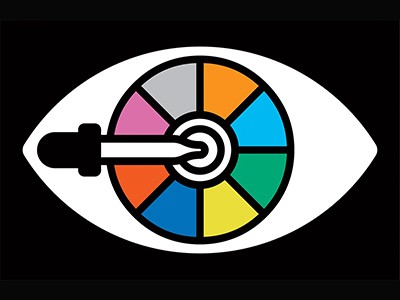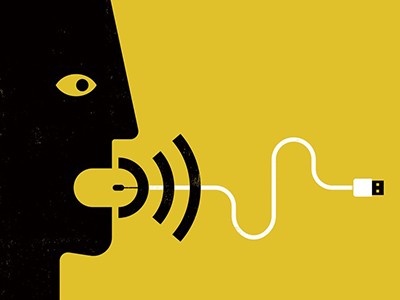Nearly 240 data scientists have proved themselves nimble enough at their work to be certified instructors for the ‘tidyverse’, a popular package for manipulating and visualizing data in the R programming language. JooYoung Seo is unique among them — the first blind instructor to gain certification.
Most tidyverse users present data in the form of charts and graphs. Seo, an information and learning scientist at the University of Illinois at Urbana–Champaign, who lost his sight at age ten owing to glaucoma, uses touch, sound and speech. He is one of a small but growing group of researchers working to make science more accessible to people with limited vision. “The overarching challenge is that content is visually designed,” Seo says. “But visualization is only one of the representation methods. We can represent data in multimodal ways.”
There are no good estimates of how many scientists with low vision are working today, but a 2020 study1 found that fewer than 100 of 52,124 researchers applying for funding from the US National Institutes of Health (NIH) in 2018 self-identified as having a visual impairment. “It’s a fraction of a fraction,” says Bonnielin Swenor, an epidemiologist and director of the Disability Research Center at Johns Hopkins University in Baltimore, Maryland, who led that work. That’s far short of the total number of scientists with vision disabilities, Swenor adds, because ableist hurdles prevent many scientists from applying for research grants. And it’s an even smaller fraction of the number of individuals with visual disabilities overall: in 2017, some 7 million people in the United States (2.17% of the population) were living with ‘uncorrectable’ loss of visual acuity or with blindness2. “If the goal is parity with prevalence in the US — which I argue it should be — we aren’t close,” she says.
Avoiding workarounds
That’s in part because, all too often, even the most basic research activities — accessing the literature, submitting papers, attending conferences and reviewing manuscripts — require time-intensive, personalized workarounds. “Blind scientists probably have a way that works for them,” says Daniel Hajas, an innovation manager at the Global Disability Innovation Hub at University College London who works to accelerate assistive technologies to market. “But it’s not generalizable and it took them a long time to get there.”
Swenor, who has degenerative retinal disease, recalls that a mentor early in her career advised her that she would have to work four times as hard as sighted colleagues to succeed in science. “That should not be the path, for anyone,” she says. But awareness of the need for accessibility in science is growing, and new tools are on the way.
Colour me better: fixing figures for colour blindness
People whose visual acuity is too low for them to read magnified text generally use screen readers, which convert digital text into either synthesized speech or a tactile (Braille) display.
Screen readers navigate digital documents using tags that identify elements such as headers, figures, tables and footnotes. But the devices often stumble on PDF files, which have long been the default digital format for journal articles and other research materials, because they generally lack such tags. The two-column format widely used in journals can also confuse screen readers, which generally read from left to right across a page. PDFs can be made accessible, but it’s challenging to do and many publishers haven’t got there yet. “Improving PDF accessibility requires changes to culture, systems and processes that can be challenging for publishers to achieve,” says Jude Robinson, a global lead for Springer Nature Digital in London. “We are committed, however, to doing this.” (Nature’s news team is editorially independent of its publisher, Springer Nature.)
An online tool called SciA11y, developed by the Allen Institute for Artificial Intelligence (AI2) in Seattle, Washington, uses machine learning to extract the content and structure of a PDF (and other file formats, such as LaTeX) and re-render it in HTML, creating a table of contents containing links to tagged section headings that can be navigated with screen readers. AI2 has also built in functionality such as bidirectional navigation between in-line citations and their corresponding references in the bibliography, says Jonathan Bragg, who co-leads the project.
In a detailed survey3, six scientists with vision loss described how they frequently found themselves unable to access or read PDFs. One respondent mentioned that they encountered problems two-thirds of the time, and that they use at least six different approaches to read papers. “It was eye-opening to see the range of tools that people use when reading — and the struggles they have when those papers have not been formulated appropriately,” Bragg says.
Speaking in code: how to program by voice
At the moment, SciA11y — ‘a11y’ is Internet shorthand for accessibility — is an online demo: researchers can upload PDFs to re-render them in HTML. But the team is still working on key functionality, Bragg says. For example, the software still makes mistakes, sometimes failing to pull out headings and leaving them as body text in the HTML. It also struggles with tables and images, which is a current focus of development.
In that respect, SciA11y is not unique: for visually impaired people, tables and images present challenges that are even harder to solve than text itself. Precious little scientific literature — whether in PDF, HTML or another format — includes textual descriptions of figures, called alt text, that would enable a blind or low-vision person to understand the images. What’s more, it’s not always clear what sort of explanation would be most relevant. “There are different schools of thought,” says Amy Bower, a blind physical oceanographer at the Woods Hole Oceanographic Institution in Massachusetts. “Should you just describe what’s there, or should you add the interpretation?”
Some researchers, including Bower, solve this issue by working with sighted interpreters. Hajas is collaborating with researchers at the Massachusetts Institute of Technology in Cambridge and others to design Olli, a screen-reader interface that allows users to navigate up and down different levels of description — from a single sentence explaining a figure’s main takeaway, to a more detailed characterization of the axes and legend, to the actual data values from which it is built. Olli currently supports basic chart types, such as bar charts and scatterplots, and Hajas says that the team is working on new features, such as heat maps.
Seo is also developing a data visualization tool, and he is drawing on more than just speech. The tool, called the multimodal access and interactive data representation system (MAIDR), encodes data as both sounds — termed sonification — and Braille, providing tactile analysis with the help of a refreshable Braille display. “I can hear the trend of the data in sound, and feel the pattern,” Seo says.
Experiencing data through touch can be especially powerful, says Mona Minkara, a computational chemist and bioengineer at Northeastern University in Boston, Massachusetts, who began to lose her vision as a young child. Minkara collaborated on a 2022 study4 that described representing data as 3D-printed graphics called lithophanes. Produced from plastic thin enough for light to shine through, lithophanes can encode multiple forms of chemical and life-science data — for example, a scanning electron micrograph of a butterfly wing, the bands of an electrophoresis gel or the ultraviolet spectrum of a protein. The technology, she says, allows her and her sighted laboratory colleagues to engage with the same data at the same time.
NatureTech hub
Feeling a change in protein function through your fingers as a difference in thickness, for example, “adds a layer of knowledge”, she says, regardless of whether a researcher can perceive that change visually. “It’s going to embed into your imagination and be more a part of you, so you understand it on a deeper level.”
Sonification provides another way for scientists with visual limitations to ‘see’ data, for instance in astronomy. “We are used to thinking that astronomy is a visual science, but most of the data that we get are just numbers,” says Anita Zanella, an astronomer at the Italian National Institute for Astrophysics in Rome. “We translate them into images because that’s a way for us to make sense of them”, but ears are often better at detecting faint signals. By translating numerical values into sounds with certain parameters — for example, a star’s brightness might be encoded as pitch — researchers can home in on important changes5.
Researchers in genomics and geology are also exploring sonification, although shared principles and standards that would allow scientists to compare data in auditory formats are still in development, Zanella says. Still, simple online tools, such as the Highcharts Sonification Studio, developed at the Georgia Institute of Technology in Atlanta, allow researchers in any field to upload data and explore ways to represent them aurally.
In addition to new tools, mindsets have advanced substantially over the past five years as researchers and developers increasingly consider accessibility, according to several researchers interviewed for this article. And in the United States, at least some federal funding bodies have made accessibility a priority. On 30 December, the NIH published recommendations (see go.nature.com/3gtmtk2) for breaking down ableism and creating equitable and inclusive research practices. (Swenor co-chaired the NIH’s Subgroup on Individuals with Disabilities, which developed the proposals.)
But for researchers with vision loss to truly succeed, tools will have to evolve beyond piecemeal efforts, Hajas says. “Unless we make the whole ecosystem accessible — how to find articles, how to read the text, how to access the diagrams and everything else — there will be missing pieces that essentially disable people from becoming good scientists,” he says.





